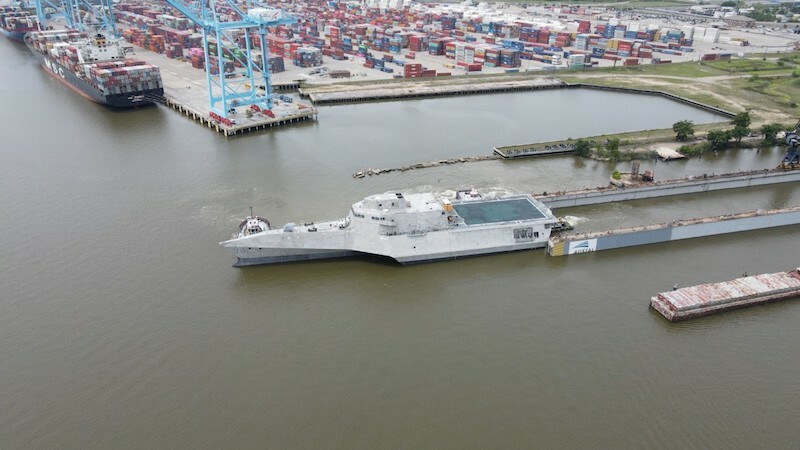Yesterday, Austal USA launched the 17th Independence-variant littoral combat ship (LCS), the future USS Augusta (LCS 34), in Mobile, Ala.
Assisted by tugs, the 421'6"x103.7' aluminum trimaran vessel was escorted out of Austal USA’s floating drydock and secured pier side on the waterfront for machinery commissioning and system activation in preparation for sea trials later this year.
The launch of Augusta was a multistep process which involved lifting the 2,500-metric-ton ship almost three feet in the air, moving it approximately 400' onto a moored deck barge adjacent to the assembly bay – using transporters - then transferring the LCS from the deck barge to a floating drydock. The floating drydock was submerged with LCS 34 entering the water for the first time.
Main propulsion for LCS 34 will come from twin GE LM2500 and two MTU 20V 8000 marine engines connected to four Wärtsilä steerable waterjets. Running speed is 40 knots.
“We’re proud to announce another successful milestone achievement for the LCS program at Austal USA,” Austal USA Vice President of New Construction Dave Growden, said in a statement. “Austal USA’s team of talented shipbuilders are excited to have another LCS in the water and are looking forward to delivering her to the Navy so she can join her sister ships in the Pacific fleet.”
The LCS is a fast, agile, mission-focused platform designed to operate in near-shore environments. The LCS is capable of supporting forward presence, maritime security, sea control, and deterrence.
With capabilities focused on defeating global challenges in the littorals, these surface combatants are designed to provide joint force access in the littorals. LCS can operate independently or in high-threat environments as part of a networked battle force that includes multimission surface combatants.
Augusta is the 17th of 19 Independence-variant LCSes that Austal USA is building for the Navy. Five LCS are under various stages of construction. Austal USA is also constructing four expeditionary fast transport ships for the Navy and will begin construction on Navajo-class towing, salvage, and rescue ships this summer.




